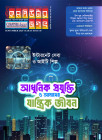হোম > Towards a web revolution
লেখক পরিচিতি
লেখকের নাম:
ঈদাত অপূর্বা সিংহা
মোট লেখা:৯
লেখা সম্পর্কিত
পাবলিশ:
২০০৮ - মে
তথ্যসূত্র:
কমপিউটার জগৎ
লেখার ধরণ:
মোবাইল
তথ্যসূত্র:
ইংরেজি সেকশন
ভাষা:
বাংলা
স্বত্ত্ব:
কমপিউটার জগৎ
Towards a web revolution
No doubt Internet has changed the art of our lifestyle and brings profound impact in human civilization. Internet is considered as a virtual world of resources where people get almost everything to meet usual needs. Internet is basically a network of networks and it is gradually expanding day by day. When any person surf the net he/she just invoke into this giant network. Website is an integral component of the Internet that promulgates information to the people.
It is indeed a real challenge to find out the right content from numerous web pages currently available on the net. For this reason search came into reality. Search engines are special purpose websites that use software robot to extract information for the people. Apart from search engine people frequently visit different category websites that basically designed to collect information. These web-based activities are categorised into three different segments commonly known as Web 1.0, Web 2.0 and Web 3.0.
Web 1.0 refers kinds of websites that are only capable to deliver basic web services such as give info about any person, organization, event and commodity. Web 1.0 standard websites are not interactive and visitors have no scope to change or add something to enhance the web-page content. Despite these features of Web 1.0 someone may disagree to distinguish Web 1.0 and Web 2.0.
Critics argue that Web 2.0 doesnt refer to a specific advance in web technology. Instead, Web 2.0 defines some standard for web page design and execution. Some of these techniques have been around since the World Wide Web (WWW) first introduced, so its impractical to differentiate Web 1.0 and Web 2.0 in a time line. The definition of Web 1.0 completely depends upon the definition of Web 2.0.
Web 2.0 gives more liberty to the visitors. This category sites allow visitor to give feedback, make causal changes, create network with others and many things to reinvigorate online travel. For instance, Amazon.com allows visitors to post product reviews. Using an online form, a visitor can add information to Amazons pages that future visitors will be able to read.
The underlying reason for the popularity of Web 2.0 is it empowers social networking. Social networking sites like Facebook and MySpace are popular in part because they make it easy for users to find each other and keep in touch.
Web 2.0 also leverages the information gathering tactics. Today, Internet surfers can subscribe to a Web pages Really Simple Syndication (RSS) feeds and receive notifications of that Web pages updates as long as they maintain an Internet connection.
Mobility is another exiting solution of Web 2.0. Nowadays people are able to access the websites through devices like cell phones or video game consoles.
These are amazing stories of Web 2.0. But Web 3.0 is more dynamic and revolutionary. Web 3.0 category browsers allow more sensible and precise search. Experts have predicted that people will get more interactive approach by the advent of Web 3.0. It also redefines the existing information searching strategies.
In essence, Web 3.0 is an intuitive solution that will support next generation computing such grid and cloud computing. It is based on technologies such as open APIs and protocols, open data formats, open-source software platforms and open data. It will also incorporate intelligent applications such as natural language processing, machine learning, machine reasoning, autonomous agents etc. In addition, Web 3.0 also paves the way of 3D web experience.
লেখাটি পিডিএফ ফর্মেটে ডাউনলোড করুন
পাঠকের মন্তব্য


